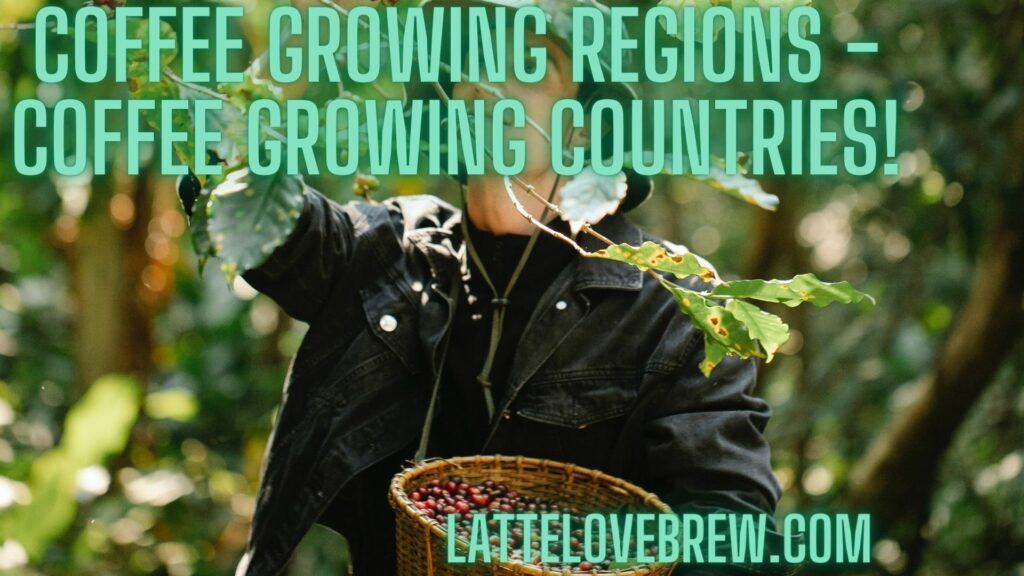Last updated on May 20th, 2024 at 11:47
If you were asked what the coffee growing regions and coffee growing countries are I’m sure that you would rhyme off Central and South America, Africa and Asia while naming Brazil, Colombia and Kenya as coffee growing regions and countries, but would you have named America?
Yes!
America produces coffee, quite a surprise for many that th good ol’ US of A is a coffee producing country!
(although very little is produced!)
Keep reading to find out more about the coffee growing regions of the world and who the top 10 coffee grown countries are!
Coffee Growing Regions
Table Of Contents
Many coffee lovers make the error of thinking that the coffee growing regions are Central and South America, The Middle East, Asia and Africa while forgetting one, the often forgotten and important coffee growing regions…
…North America!
While the US and Canada really don’t have the idea climate for the cultivation of coffee it is grown in Hawaii where you will find the tasty Kona coffee, which is primarily Volcanic coffee. California also produces coffee, in very small amounts.
Let’s not forget that Mexico, which is also North America, is the 9th largest producer of coffee. Of course Cuba and Puerto Rico are part of continental North America.
The one thing that stands out about all the coffee producing nations is they form a zone called the coffee belt that runs from the tropic of Capricorn to the tropic of cancer and runs all over the world like a belt, hence the name, the coffee belt.

Read: Does coffee grow on trees?
Where Does Coffee Grow Best?
Coffee is grown best in tropical climates where the soil is rich in nutrients and there are few pests or diseases that will affect the coffee tree. This is one of the reasons that coffee is grown in the coffee belt that expands the tropical zones and across the globe.
The optimal temperature for growing coffee is 18C to 21C (64F to 70F). While tropical countries can provide much warmer climates, this is the reason why you will find coffee being cultivated at altitudes and an elevation where it is slightly cooler.
While coffee can tolerate and survive temperatures of 24C (73F) it becomes problematic to grow coffee at temperatures in excess of this without damaging the tree or the cherries it produces and degrading the quality of the coffee bean.
Continuous exposure to temperatures of 30C (86F) will seriously damage the coffee plants (also called coffee trees and coffee bushes!).
Can Coffee Be Grown Anywhere?
No,
Unfortunately coffee cannot be grown anywhere as it needs to certain and specific climate and temperature in which it will thrive in. It is not as simple as growing coffee in the tropics and having the mineral-rich quality soil that it needs.
Coffee needs to be grown at a temperature of 18C to 21C (64F to 70F) which means they must be grown at elevation where the temperatures are a little cooler. Coffee needs to be grown where there is plenty of sunshine, plenty of water and nutrient rich soil.
Notably too much water, too much rainfall and too much sunshine can have a negative effect on the coffee trees. It’s a difficult crop to grow!

How Hard Is It To Grow Coffee?
I’ve visited coffee farms in Hawaii, Vietnam, Thailand, Malaysia and Indonesia. The one thing that is consistent is the difficulty to grow coffee. It requires a lot of work, a lot of patience as it can take up to 7 years for the trees to produce coffee and during that time any number of things can go wrong from unexpected climatic reasons from too much sunshine, too much rain to various pests that harm the tree and generally fighting what nature throws at it.
Finally after 7 years of taking care of the new trees you get the first harvest. It’s a lot of work and is not at all that profitable for farmers. I’ve yet to meet a rich, wealthy independent coffee farmer!
Of course, growing coffee is only the first part of the process. There is picking and processing the beans and getting them ready for roasting and transportation. It’s a complex business and difficult crop to grow.
What Is The Best Region For Coffee? What Country Makes The Best Coffee?
What is best is entirely subjective and based on personal opinion and taste.
While Brazil is by far the largest producer based on volume, and like second placed Vietnam is also not known for their great quality coffee as neither Brazil or Vietnam produces grade 1 coffee, which is better known as specialty grade coffee.
The world’s third-largest coffee producer, Colombia is the world’s largest producer of specialty grade coffee. While producing less coffee than both Brazil and Vietnam, this South American country produces a better quality coffee.
In Colombia most coffee farms are small family owned farms, this is one of the reasons for their excellent coffee. Colombian coffee is wet, processed and well respected in the coffee world.
Indonesia, the tropical Asian country, is the fourth-largest coffee producer. They stand out as the highest producer of specialty grade volcanic coffee, which is tasty and mineral rich.
Tanzania while only the 18th largest producer of coffee overall is the number one producer of pea berry coffee. Pea berry coffee is a naturally occurring genetic mutation where there is only one bean in the cherry which gets all the nutrients and flavors without the need to share with its twin making it more flavorful and flavorsome.
Ethiopia, the home of coffee and where it was originally found, is the 5th largest coffee producer and the largest where coffee is naturally produced. Yirgacheffe and Sidamo are great coffees and of the specialty grade. Expect great coffee with floral notes.
Panama, while the 37th largest coffee producer of coffee, has the reputation for producing the best, the very best coffee, their Geisha coffee beans which are regularly sold at auctions for record prices. The very best baristas in the world use Panama Geisha beans to make the coffee they are brewing in world barista championship events.
Thailand, the 25th largest coffee producer in the world, is the leading producer of organic luwak coffee, the weasel coffee. Other Weasel coffees are produced in a “factory farming” method and poorly treat the weasel. In Chang Dao, in Northern Thailand, the coffee is produced organically and naturally where the animal is free to roam in its natural habitat.
Malaysia, who are the 60th largest coffee producer in the word, but is the leading producer of the rare Liberica coffee beans. You will find a very interesting tasting coffee, White coffee, which is the only coffee that is double roasted and with Margarine, a dash of salt and often sugar to caramelize the flavors. They are roasted at a very low temperature.
These are all must-try coffees and different people will tell each one is the best based on their own taste preferences. While I love a great Ethiopian coffee, I am a sucker for Tanzanian Pea Berry and an Indonesian Sumatran volcanic coffee.

Read: Where do coffee beans come from?
Which Is The Best Smelling Coffee?
Coffee is aromatic, and the best coffee is very aromatic! It’s part of the enjoyment as the scent and aroma dances around your nostrils and may even have a beneficial effect in the same way that aromatherapy does and give you a little pleasurable boost.
This is not my random guessing; there are some studies that indicate that this may be the case. The studies conducted indicated that there is a possible reinforcing effect of coffee due to the pleasurable aroma given off with the scientists stating that certain proteins and genes are stimulated that helps us to better cope with stress and negative emotions.
- 1. Guatemala City Roast: Sweet chocolate aroma.
- 2. Brazil Full Roast: Rich nutty aroma.
- 3. Colombia Bucuramanga: Fruity Aroma.
- 4. Uganda Bugisu: Rich dark chocolate aroma.
- 5. Ethiopia: Very clean, sweet citrus aroma.
- 6. India Plantation: Nice and spicy aroma.
- 7. Indonesia: Fruity aroma.
- 8. Kenya: Sweet fruity aroma.
- 9. Nicaragua Medium Roast: Fruity notes with a sweet aroma.
- 10. Costa Rica City Roast: a light caramel aroma.
The benefit of a great coffee is not only by drinking it, but enjoying the rich aromas of well brewed fresh coffee.
Frequently Asked Questions About Coffee Growing Regions
What Are The 4 Geographic Zones Where Coffee Beans Are Grown?
The world’s coffee growing regions are as follows:
- North America.
- Central America.
- South America.
- The Caribbean.
- Africa.
- The Middle East.
- Asia.
Not every country within the regions mentioned has the ability to produce coffee. The coffee growing regions can be described and visualized as placing a belt around the world covering the tropical regions from the tropic of cancer to the tropic of Capricorn and around the world in this fashion like a belt.
This belt is commonly known as the coffee belt. There are 70+ coffee producing nations in the world.
Where Is Coffee Mostly Grown?
Based on volume produced per year, by far Brazil is the number one coffee growing coffee nation in the world. Brazil mainly produces the Arabica variety. The number two coffee producing nation in the world is Vietnam, but what stands out about Vietnam’s coffee production is their coffee produced is mainly the Robusta variety.
While being the second-largest producer of coffee in the world, Vietnam is the number one producer of Robusta coffee in the world.
Where Is Gold Coffee From?
Gold coffee is at the heart of it, is an ultralight coffee that when examined looks more like teas than a cup of coffee. Golden coffee comes from Ethiopia, Brazil and Nicaragua. Gold coffee is produced at a lower temperature and for a longer period of time.
Where Does Starbucks Get Their Coffee Beans?
Starbucks sources their coffee globally. They don’t stick to one particular region, country or continent. Starbucks buys their coffee beans from all over the world with a particular focus on Latin America, East Africa and Asia-Pacific.
For the majority of their coffees they do not name the country where the beans are from or ratio in their blends. These details are a trade secret.
What Are The Top 10 Coffee Producing Nations In The World?
When coffee is produced and sold, it is sold in 60 kg bags. The top 10 coffee producing nations in the world and how many 60 kg bags are sold are as follows:
- 1. Brazil: 44,200,000 (2,652,000 Metric Tonnes).
- 2. Vietnam: 27,500,000 (1,650,000 Metric Tonnes).
- 3. Colombia: 13,500,000 (810,000 Metric Tonnes).
- 4. Indonesia: 11,000,000 (660,000 Metric Tonnes).
- 5. Ethiopia: 6,400,000 (384,000 Metric Tonnes).
- 6. Honduras: 5,800,000 (348,000 Metric Tonnes).
- 7. India: 5,800,000 (348,000 Metric Tonnes).
- 8. Uganda: 4,800,000 (288,000 Metric Tonnes).
- 9. Mexico: 3,900,000 (234,000 Metric Tonnes).
- 10: Guatemala: 3,400,000 (204,000 Metric Tonnes).
What Are The Two Main Coffee Trees?
There are 124 different varieties of coffee in the world, the two main types of coffee tree are the Coffea Arabica (Arabica coffee) and Coffea Canephora (Robusta coffee).
These two coffees account for 90% of all coffee sold in the world with a 60% and 30% split in favor of Arabica coffee.
There are other types of coffee trees like Kapeng Barako (Café Barao) which is grown in the Philippines, in Cavite and Batangas. Coffea Charrieriana which is a caffeine-free coffee that is grown in Cameroon.
Coffea Stenophyllya, which has not been seen growing in the wild for almost 70 years, was discovered in Sierra Leone.
Final Thoughts – Coffee Growing Regions
Now you know what the top coffee growing regions are and with the caveat within this article that quantity does not mean quality as none of the top two coffee producing nations produce specialty grade coffee, that is grade 1 coffee.
Even though Colombia is one of the coffee growing countries that can and does produce specialty grade coffee and is the largest producer of the highest quality coffee, their coffee is barely one that is mentioned by coffee connoisseurs as the best tasting specialty grade coffee, often failing to make their list of top 5.
Join our active, vibrant, fun and informative coffee community on Facebook/Meta and share your coffee recipes, memes, fab creations and fun jokes and quotes.







